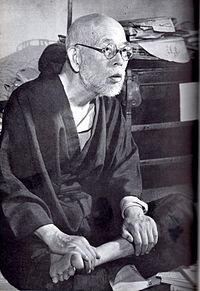Saitō Mokichi Kinenkan

|
|
| Data | |
|---|---|
| place | Kaminoyama , Yamagata Prefecture |
| Art | |
| architect | Taniguchi Yoshirō , Yoshio Taniguchi |
| opening | 1st September 1968 |
| management |
Akiba Shirō
|
| Website | |
The Mokichi Saitō Kinenkan ( Japanese 公益財団法人斎藤茂吉記念館 Kōekizaidan Hojin Mokichi Saitō Kinenkan , Kyujitai : in the case 齋藤茂吉記念館 ., Eng Mokichi Saitō Memorial Museum ) was built in honor of the Japanese psychiatrist and writer Mokichi Saitō (1882- 1953) in his hometown Kaminoyama (formerly: 金 瓶 村 Kanakame-mura ) in Yamagata prefecture . The museum collects and preserves materials to illustrate and honor Saitō's achievements and life. To this end, it provides works, especially Tankaand shows a replica of Saitō's living room and study. The exhibition on the ground floor is thematically organized. The topics are:
- Saitō's life
- Saitō's attitude as a poet
- Saitō the psychiatrist
- Manuscripts and calligraphies
- Saitō and his homeland Yamagata / Kaminoyama
- Saitō's achievements
- People with whom he used to associate
- Works by Saitō
The museum has a lecture and demonstration room on the first floor. A memorial room for Saitō's nephew has also been set up here. The museum has a website that presents a wealth of information on the life and work of Saitō.
Overview
The museum has an exhibition area of 1394 m². The plan to build a museum to commemorate Saitō was announced in 1965 on the 12th year of Saitō's death. The foundation stone will be laid the following year. The museum was planned by the architect Taniguchi Yoshirō (1904–1979), who had been recommended by the art critic Imaizumi Otsuo (1902–1984), and in 1968 it was named "Mokichi Saito Memorial of the City of Kaminoyama" ( 上山 市立 斎 藤 茂 吉 記念館 ) opened. At the beginning, the museum was run by the city administration. In 1983, management was transferred to a foundation with legal capacity. In 1985 the museum was officially registered according to the Museums Act . At the opening, the chairman of the executive committee for the building project Ōkubo Denzō (1901–1986), honorary citizen and former mayor of the city, supported the museum with his private collection. Saitō's family donated other exhibits. The artist and calligrapher Yasuda Yukihiko designed a plaque at the museum.
In 1989, the foundation received a donation from the legacy of Saitō's nephew Moriya Seijirō ( 守 谷 誠 二郎 , 1908–1985) of around 10 million euros. As a result, the son of the original architect Yoshio Taniguchi carried out additions and repairs to the museum, thus completing his father's plans and the construction of the museum. Among other things, the exhibition space on the ground floor was enlarged. In 2003, on the occasion of the 50th anniversary of Saitō's death, the equipment was renewed and a computer system was purchased. The museum was last renovated in 2018 on the occasion of the 50th anniversary of the opening. A new exhibition area has been created showing works by Saitō at the time of his return. In addition, an elevator was installed and the museum made barrier-free.
Miyuki Park is located near Saitō's actual birthplace, a little south of the museum, where he often stretched his legs from work. In addition, Saitō's study from his summer house in Hakone and memorial steles for him and the two poets Itō Sachio and Shimaki Akahiko ( 島 木 赤 彦 , 1876-1926) were transported to the museum. The study room was rebuilt in the museum, the steles are outside. The park was visited by Meiji- tennō (Mutsuhito) on a tour.
Individual evidence
- ↑ 館長 室 よ り , (Japanese), accessed November 8, 2019
- ↑ 展示 の ご 案 内 , (Japanese), accessed November 8, 2019
- ↑ a b c 斎 藤 茂 吉 記念 館 に つ い て , (Japanese), accessed November 8, 2019
- ↑ み ゆ き 公園 内 の 記念 碑 (斎 藤 茂 吉 歌 碑 , (Japanese), accessed November 8, 2019
Web links
- The Saito Mokichi Memorial Museum. 公益 財 団 法人 斎 藤 茂 吉 記念 館 , Retrieved November 8, 2019 (Japanese, Museum Official Website).
Coordinates: 38 ° 10 ′ 19.1 ″ N , 140 ° 17 ′ 57.2 ″ E